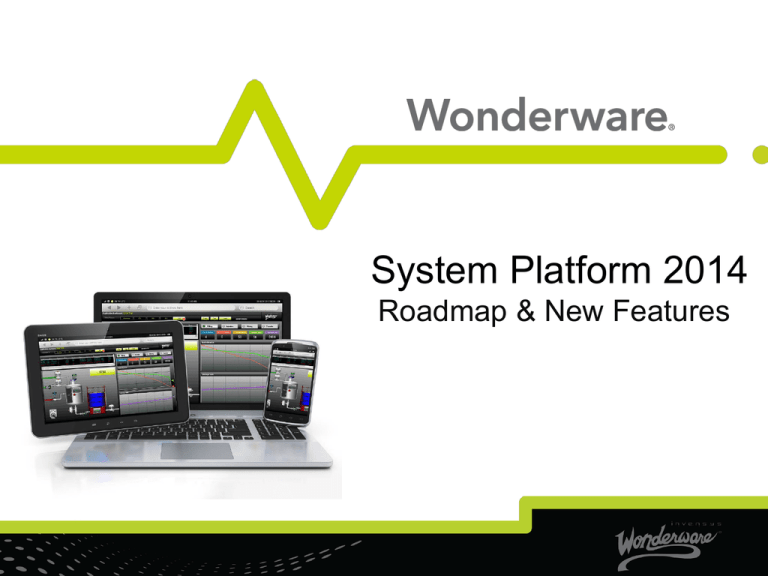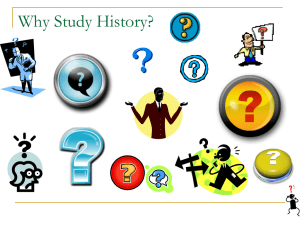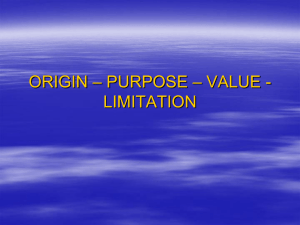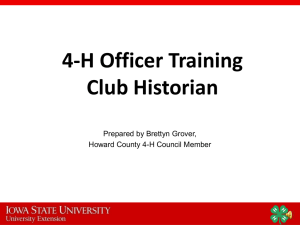SP2014 New Features
advertisement

System Platform 2014 Roadmap & New Features HMI Supervisory Roadmap Wonderware System Platform /InTouch 2012 R2 InTouch 2012 R2 Extension Wonderware System Platform \InTouch 2014 •Device Integration Updates •Multi-Galaxy Runtime •Raised Historian Scalability •Dual Historian •InTouch Machine Licensing •Semantic Model •Access Anywhere •HTML5 InTouch Access •No Graphic Conversion •100% InTouch Functionality •Scripting improvements •Unified Historian •New Animations •Situational Awareness Lib •Alarm Aggregation •Template locking •Styles •Symbol Wizards •OPC UA client •New License tool Q4-2012 Q3-2013 Q4-2013 CY-2015 Atypical ( A typical ) Topology… Visualization Node Visualization Node Engineering Station Engineering Station InTouch InTouch IDE IDE InTouch InTouch Bootstrap Bootstrap Bootstrap Bootstrap Galaxy Rep. Historian Info Server Bootstrap Bootstrap Historian Information Server Bootstrap Bootstrap Bootstrap AutomationObject Server AutomationObject Server Galaxy Repository IO Server Bootstrap I/O Data Server Workstation New with System Platform 2012: Simplified Installation – Single DVD Multiple setup options: • Role Based • Product Based • Both can be customized 1 install disc Installation User Interface Cadence Release: Wonderware System Platform 2012 Released November 2011 • Wonderware InTouch HMI 2012 (v10.5) • Wonderware Application Server 2012 (v3.5) • Wonderware Historian Server 2012 (v10.0 SP1) • Wonderware Historian Client 2012 (v10.0 SP2) • Wonderware Information Server 2012 (v4.5) Cadence Release: Wonderware System Platform 2012 R2 Released December 2012 • Wonderware InTouch HMI 2012 R2 (v10.6) • Wonderware Application Server 2012 R2 (v3.6) • Wonderware Historian Server 2012 R2 (v11.0) • Wonderware Historian Client 2012 R2 (v10.1) • Wonderware Information Server 2012 R2 (v5.0) Cadence Release: Wonderware System Platform 2014 Scheduled Release: December 2013 • Wonderware InTouch 2014 (v11.0) • Wonderware Application Server 2014 (v4.0) • Wonderware Historian Server 2014 (v11.5) • Wonderware Historian Client 2014 (v10.5) • Wonderware Information Server 2014 (v5.5) System Platform 2014 New Features InTouch 2014 (v11.0) Application Server 2014 (v4.0) • Situational Awareness Library • Multi-Galaxy Communication • Element Styles • ArchestrA Service Bus • Symbol Wizards • Template and Symbol Protection • New Animations • QuickScript Editor Scripting Enhancements • Alarm System Enhancements • Technology Updates • Graphic Performance Index • Owning Object • InTouch Access Anywhere Historian 2014 (v11.5) • Historize Alarms & Events from Wonderware Application Server • Support for 2M I/O at Tier 2 • New SDK toolkit New Technology Support • Windows 8, Server 2012 • .NET Framework 4.5 • SQL Server 2012 SP1 2014 Introducing InTouch Access Anywhere • Full web-based access to InTouch applications from anywhere anytime regardless of platform or location. • Runs in HTML5-compliant browsers (IE, Safari, Chrome, Firefox, etc.) • No Flash, Java, ActiveX, Silverlight or other special software needed. • Doesn’t require installing or configuring any client-side applications. • Platform-agnostic: - Runs on a variety of devices (Desktops, Laptops, Tablets, Smart Phones, Smart TVs and more) - Running on a variety of platforms (Windows, iOS, Android, Linux,…) • Provides secure access - Same OS-based security as Remote Desktop - Supports HTTP, HTTPS, and SSL. - Natively supports RDP encryption. InTouch® Access Anywhere Benefits Feature Benefit • Mobility & Cost savings. Access and control your InTouch® (includes alarms &data history) from anywhere regardless of the platform or location! (mobility-enabler) • The ability to troubleshoot plant equipment from the office, home or on the road provides an unprecedented level of flexibility that maximizes engineer’s output. Ability to connect the most suitable resources instantly on a project saving the cost of travel • Use any HTML5 enabled Device! (Android, Chrome, iPad, Mac, Linux, HMTL • 5 TV) • Runs on the browser • Does not install anything on the client • Ability to remember what you worked on Business continuity • • One secure link-no programming required No maintenance……… Security All of the above with no compromise on InTouch® functionality! InTouch Access Anywhere REMOTE ACCESS Mobile Users Casual Users Industrial Computer Visualization Node Engineering Station Casual Users Automation Object Server Automation Object Server Galaxy Repository Historian InTouch Terminal Server + InTouch Access Anywhere I/O Data Server Mobile Users Plant Any location RDP Compression and Acceleration • Enhances remote desktop performance over the Internet. • Image compression: Compresses images before transmitting them to the browser for rendering. • Packet shaping: Optimizes the network messages to improve network utilization and performance. • Whole frame rendering: The display is updated as a whole rather than in blocks, as performed by standard RDP. Coupled with the other optimization features, it results in a smoother display that more closely resembles the functionality on local desktops. Remote User Log-In 1. Open a web browser 2. Enter URL or IP of the InTouch Access Anywhere Server 3. Select InTouch application (if more than one exists on the server.) 4. Enter valid credentials 5. Click on “Connect” System Requirements Server side • Windows Server OS • Remote Desktop • InTouch 2012 R2 • InTouch TSE Concurrent licenses (Windows 2003 Server, Windows 2008 Server SP2) Client End: • HTML5 compatible browser including, but not limited to: - Internet Explorer 10 or IE6 - IE9 - Chrome 12 or higher - Safari 5 or higher - Firefox 6 or higher - Opera 11 or higher - Amazon Silk (with Google Chrome Frame) Changing Operator Role – Market Trend 1970’s 1980’s 1990’s Safe Reliable Efficient Effective Present Modern HMI: Today we can almost anything Realistic 3D equipment. Millions of shades of color. Animated flames, flows, motors. Without the Decoration Opportunity: Situational Awareness • Enhance the operator’s Situational Awareness of current process conditions. • Leverage a variety of visual techniques within the HMI. • Increase contrast between normal operating conditions and alarm states requiring action. • Largely monochrome color palette. • Display vivid colored alarm states. • Graphics purposely not photo realistic. • Provide just enough visual detail to deliver functional purpose without showing extraneous information to operators. Situational Awareness Symbols Traditional HMI What Happened ? Critical Alarm Grid Process Tool Trends Knowledge Operational Operator Limits Tool Impact SAL Graphics What is Happening ? Knowledge Operator Alarm Boundaries Interpretation time Time Alarm - 40 % Situational Awareness Symbols Library Consistency through Element Styles Ability to Choose from Multiple Palettes Symbol Wizard: Example Opportunities Symbol Wizards Simple Case: Pilot Light Many Symbols 1 Wizard 2 Options: Bezel Thickness Color 33 Example: Multiple Bar Graphs 34 Symbol Wizard – Bar Graph Rules Rules 35 New Animation: Points “S T 4 ” sta rts to in cre a se ST4 ST3 ST1 ST2 36 New Animation: Alarm Border 3 4 2 1 New Animation: Sweep Angle Example: RPM Meter Optimal range is shown by shaded area. Dynamically established. Supported Elements: • Arcs • Pies • Chords New Graphic Element: Trend Pen New Graphic Element: Trend Pen Programmatic Graphic Generation • Publish open XML Schema • Export Graphic as XML • Import Graphics as XML • Programmatic access to Import/Export Export ArchestrA Symbol XML Configuration Repository Import Owning Object • Owning Object can be set without scripting, browsing or typing. • Easier to define the graphics from the graphic toolbox. Graphic Performance Indication 2014 44 Estimating Bandwidth/Storage Alarm DB Logger Configuration ? 20 steps Alarm History Stack Application Server 2012 R2 History Blocks SQL Server WWALMDB Process History Store-forward Redundancy Compression Bandwidth Limit HCAP WCF HCAL SQL Connection Alarm DB Logger Alarm Manager Application Application Server Server Opportunity for improvement Alarm History Stack Application Server 2014 History Blocks SQL Server WWALMDB History Store-forward Redundancy Compression Bandwidth Limit HCAP WCF HCAL Application Server* * No change for InTouch Alarm/Event History New Alarms & Events In Historian Same Historian configuration: • Server • Redundant Historian • Store forward • Bandwidth Filtering Historized Alarms & Events Redundant Alarm History Client Switching (active-passive) Redundant Historians (active-active) A2ALMDB A2ALMDB HCAP HCAP HCAL Application Server * Integrated View View • Lists show alarm severity • Alarms/acknowledgement on trends • Operator actions overlayed OverView • Part Of Information Server • Released in System Platform 2012 R2 • Updated in System Platform 2014 • Also works with legacy WWALMDB Coming: Block-Based Alarm History Storage • Alarm/Event stored in History Blocks Application Server 2014 R2* • Easily archive/purge/restore using Windows Explorer History Blocks • Flexible structure Performance • Significantly higher rates • Capacity limited by space, not insertion rate Licensing HCAP WCF HCAL Application Server • May require Enterprise Edition • Otherwise, use A2ALMDB * Tentative—expected in CY 2014 Alarm DB Logger Still used for: • Standalone InTouch • ASP upgrades with existing DB Logger • Stores to WWALMDB Thousands Historian Scalability 2,000 1,500 2,000,000 tags 1,000 500 7.0 8.0 9.0 2 million tags only supported via Replication (from a “Tier 1”) 10.0 2012 R2 2014 Tag Meta Data Historian 2012 R2 & Earlier Historian 2014 Runtime DB History Blocks Historian 2014 Status Panel Historian Private Name Space Historian Client Windows User Management Logins SQL: Per Login Windows Group: Per Login (not per User) SQL Server Management Studio Historian 2014: Private Name Space New “GroupedPrivateNamespace” System Parameter 0 = “Private” shared with Group 1 = Each account has Private namespace Historian Client Logins SQL: Per Login Windows Group: Per Login (not per User) SQL Server Management Studio New System Tags Tag SysStatusMode Description Tracks server state (read/write, read-only, down) SysStatusSFDataPending Indicates outstanding store-forward data SysStatusAverageEventCommitSize # property values written together SysStatusAverageEventCommitTime Time required to write the properties SysStatusEventCommitPending # events awaiting commit SysStatusRxEventsPerSec Alarm/event throughput SysStatusRxTotalDuplicateEvents Events discarded because detected as duplicate SysStatusRxTotalEvents Cumulative alarm/event collection Historian Toolkit Updates Historian 2012 R2 Toolkit • Query history for all tags, including Summary Tags • Only works with Historian 2012 R2 (aka 11.0) • Only .NET 4.0, Application Server 2012 R2 (aka 3.6) • Uses single TCP port for communications • All new interface (though mapping is straightforward) • Does not include tag listing (use SQL) Historian 2014 Toolkit • Built-in redundant Historian support • SQL query “tunnel” returns ADO.NET RecordSet Online Edition User Subscription • Historian • Historian Client • SmartGlance Historian Client “Tier 1” Historian Control Network I/O InTouch Application Server Wonderware Historian 2014 • Continued scalability gains – Tag Count – Retrieval Load • First step toward integrated alarm & event history – Robust alarm/event history – Scalability improvement (modest) • Improved Historian Toolkit • Truly private name space for group logins Historian Client 2014 Office 2013 Support 32-bit only 2014 65 Refocus ArchestrA Target Users # Users InTouch ArchestrA System Platform Given the right skill level ArchestrA delivers unmatched business value. Goal: We must enable users to deliver System Platform functionality that exceeds InTouch and is even easier to use. Novice Expert Skill Level Visualization Evolution Two Releases to Achieve InTouch ArchestrA InTouch 2012 R2 InTouch View 9.0 InTouch 8.0 InTouch 7.x Layout & Navigation Layout & Navigation Layout & Navigation Displays Symbols Scripts Security Tags History Alarms Layout & Navigation Displays Layout & Navigation Devices Displays Displays Displays Smart Symbols Faceplates ArchestrA Graphics Symbols Smart Symbols Faceplates Scripts Security Tags History Alarms …. Scripts Security Tags History Alarms …. Scripts Security Tags History Alarms …. Scripts Security Tags History Alarms …. Displays Alarm Improvements • Storage Improvements • Updated Clients • Severities • Store Forward • Redundancy • Simplicity Runtime Alarms in Context with Awareness • EEMUA 191: Alarm systems a guide to design • Namur NA 102 Worksheet: Alarm Management • NPD YA 711: Principles for alarm design (Norwegian petroleum doctorate slowly adopted throughout Europe as the standard) • VDI/VDE Guideline 3699 (process control using monitors) • ISA S18.02, Management of alarm systems for the process industry ANSI/ISA 18.2 Management of Alarm Systems for the Process Industries API RP-1167 Alarm Management For Pipeline Systems Applying Industry Guidelines 1.Alarm Priorities: Priority Priority Priority Priority Priority 2.The system shall only represent four active alarm priorities: 1 Critical (only Safety and Emergency related) 2 High 3 Medium 4 Low 5 Events and logging only no Alarms. 1.The four priorities and the impact to the business and operation. 2.Ranking and economical scale: Operational risk of the Alarms. Define response times for each category Severity Indication on Alarm Borders Severity 1 response time < 5min Severity 2 response time < 30min Severity 3 response time < 60min Severity 4 response time < 120min Wonderware Implementation Global Styles for Alarm Colors and Borders One place to change how alarms are represented to entire project. Alarm Border Animation Runtime Global Icons Global Styles Auto Configuration for Field_Attributes or objects Awareness at Every Level: Built in Alarm Aggregation Alarm Clients: The Current Method Alarm Clients: Updated Historical • Defined with standard Themes and Styles • Fonts best Practices HMI Standards • Dynamic Filter tabs • Group By functionality • Area tree filter Alarm Clients: Updated Runtime • Tabbed filtering • Actual alarm indicators on Tabs • Ack buttons • Styles and themes setup as default Standards Management • Reuse of baseline application/components • Application Integrity • Change Management • Installed-Base Management Standards Management: Protected Objects & Symbols Source Galaxy Export Export Import Import Destination Galaxy Standards Management: Protected Objects & Symbols Coming soon… Improved Connectivity OPCUA Client – Data Access • Security • Fault Tolerance Engineering Efficiency Script Editor: • Auto complete function − Me. − MyContainer. − Scripts • • • • Multi level Undo-Redo Line Numbering Consistent color coding Syntax Error Indication 2014 Engineering Efficiency Scripting: Exception Handling Trap Exception Handle Exception 2014 General Improvements • Removal of platform breach message • Removed standard object description • Dialog boxes reflect proper action (cancel on deploy) • OPC browser DI Object fixed • Default engine execution time reduced to 500ms • Default DI Object scan time reduced to 250ms • Checkpoint file write frequency now 10 seconds default • Use of localhost as GR or Historian name • Changed redundancy communication port text on platform • Dialog when importing clients or script libraries to indicate the affected objects and to cancel import operation • Alarm Manager now able to co exist in multiple sessions IT Compliance • User Account Control (UAC) fully supported. • System Platform install with SQL Server Express. • Machine name, rename after install is supported. • Silent install scripts are included with install DVD. • ArchestrA User can now be Non-Interactive. • Support for network based installation. • Support in A2ALMDB for domain based or integrated security. • New updated icons for legacy Alarm Manager. Updated Operating System, .NET Framework, Virtualization, and SQL Server Requirements New Invensys License Manager Where to find a list of these New Features? Reference Document on WDN (200 pages) HMI Supervisory Roadmap Wonderware System Platform \InTouch 2015 Wonderware System Platform /InTouch 2012 R2 InTouch 2012 Extension Wonderware System Platform \InTouch 2014 •Device Integration Updates •Multi-Galaxy Runtime •Raised Historian Scalability •Dual Historian •InTouch Machine Licensing •Semantic Model •Access Anywhere •HTML5 InTouch Access •No Graphic Conversion •100% InTouch Functionality •Scripting improvements •Unified Historian •New Animations •Situational Awareness Lib •Alarm Aggregation •Template Locking •Styles •Symbol Wizards •OPC UA client •New License tool •Ease Of Use Redesign •ArchestrA Displays •Content Frames/Panes •Multi-Touch Support •Object Wizards •Model Based Navigation •Simplified IO Linkage •Contextualized Data •Alarm Shelving •Graphic Security •Much More! Q4-2012 Q3-2013 Q4-2013 CY-2015 Schneider Electric – no changes announced Slide 91








